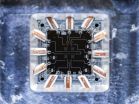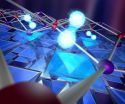(Press-News.org) Making friends is often extremely difficult for people with social anxiety disorder and to make matters worse, people with this disorder tend to assume that the friendships they do have are not of the highest quality.
The problem with this perception, suggests new research from Washington University in St. Louis, is that it's not necessarily true from the point of view of their friends.
"People who are impaired by high social anxiety typically think they are coming across much worse than they really are," said study co-author Thomas Rodebaugh, PhD, associate professor of psychology in Arts & Sciences. "This new study suggests that the same is true in their friendships."
The study, published this month in the Journal of Abnormal Psychology, finds that people with social anxiety disorder often overestimate how bad their relationships are with friends, when compared to what the friends say.
Much more than simple shyness, social anxiety disorder is a recognized psychiatric condition in which those struggling with the affliction often live in fear of meeting new people, passing up social invitations or work opportunities for fear of being rejected, embarrassed or otherwise singled out as a failure.
By some estimates, 13 percent of people in Europe and the United States experience social anxiety disorder. The disorder ranges in severity, from less severe, yet impairing fears of a single situation (most often public speaking), to fears about interacting with people in general.
Based on a battery of psychological tests designed to assess friendship quality, Rodebaugh's study involved a group of 112 participants, each diagnosed as having or not having social anxiety disorder. Each participant brought along a friend from a non-romantic relationship who agreed to take part in the testing.
"People with social anxiety disorder report that their friendships are worse, but their friends didn't see it the same way," Rodebaugh said. "Their friends seem to say something more like: 'It's different, but not worse.' "
People with social anxiety disorder reported that their friendships were significantly worse (as compared to people without the disorder). These misperceptions were stronger and more prevalent among younger study participants and in situations where the friendship was relatively new, researchers found.
"The friends of people with social anxiety disorder did seem to be aware that their friends were having trouble, and additionally saw the person with social anxiety disorder as less dominant in the friendship," Rodebaugh said.
The findings could play an important role in helping people with social anxiety disorder understand that their friendships may not be as terrible as they might imagine. Helping people form friendships is in itself important, because many studies confirm that the lack of strong social networks can leave people vulnerable to a host of problems, including disease, depression and even earlier mortality, Rodebaugh said.
The good news is that social anxiety disorder is treatable. Decades of research suggests that talk therapy, such as cognitive behavioral treatment, is as, or even more, effective than medications for long term treatment of the disorder.
"Current treatments focus, in part, on helping people with social anxiety disorder see that they come across better than they expect they will," Rodebaugh said. "Our study suggests that's true for specific friendships as well."
INFORMATION:
The study was conducted by Rodebaugh with help from a postdoctoral fellow, as well as psychology graduate students in the Anxiety and Psychotherapy Laboratory at Washington University, including Michelle H. Lim, PhD; Katya C. Fernandez, PhD; Julia K. Langer; Jaclyn S. Weisman; Natasha Tonge; Cheri A. Levinson; and Erik A. Shumaker, PhD.
Lim is now a postdoctoral research fellow at Swinburne University of Technology in Melbourne, Australia. Shumaker is now a psychology research fellow with the Veteran's Administration Healthcare System in Boston. Fernandez is now a postdoctoral scholar at the University of California, Berkeley.
The research is supported by grants from the National Institute of Mental Health (MH090308) and the National Institutes of Health (UL1 RR024992).
While the Martinis Lab at UC Santa Barbara has been focusing on quantum computation, former postdoctoral fellow Pedram Roushan and several colleagues have been exploring qubits (quantum bits) for quantum simulation on a smaller scale. Their research appears in the current edition of the journal Nature.
"While we're waiting on quantum computers, there are specific problems from various fields ranging from chemistry to condensed matter that we can address systematically with superconducting qubits," said Roushan, who is now a quantum electronics engineer at Google. "These ...
It's not uncommon to see cameras mounted on store ceilings, propped up in public places or placed inside subways, buses and even on the dashboards of cars.
Cameras record our world down to the second. This can be a powerful surveillance tool on the roads and in buildings, but it's surprisingly hard to sift through vast amounts of visual data to find pertinent information - namely, making a split-second identification and understanding a person's actions and behaviors as recorded sequentially by cameras in a variety of locations.
Now, University of Washington electrical ...
ITHACA, N.Y. - Peering deep into time with one of the world's newest, most sophisticated telescopes, astronomers have found a galaxy - AzTEC-3 - that gives birth annually to 500 times the number of suns as the Milky Way galaxy, according to a new Cornell University-led study published Nov. 10 in the Astrophysical Journal.
Lead author Dominik Riechers, Cornell assistant professor of astronomy, and an international team of researchers gazed back - with the Atacama Large Millimeter/submillimeter Array (ALMA) in Chile - over 12.5 billion years to find bustling galaxies creating ...
New York, NY - The female mosquitoes that spread dengue and yellow fever didn't always rely on human blood to nourish their eggs. Their ancestors fed on furrier animals in the forest. But then, thousands of years ago, some of these bloodsuckers made a smart switch: They began biting humans and hitchhiked all over the globe, spreading disease in their wake.
"It was a really good evolutionary move," says Leslie B. Vosshall, the Robin Chemers Neustein Professor and head of the Laboratory of Neurogenetics and Behavior at The Rockefeller University, and a Howard Hughes Medical ...
As cities and incomes increase around the world, so does consumption of refined sugars, refined fats, oils and resource- and land-intense agricultural products such as beef. A new study led by University of Minnesota ecologist David Tilman shows how a shift away from this trajectory and toward healthier traditional Mediterranean, pescatarian or vegetarian diets could not only boost human lifespan and quality of life, but also slash greenhouse gas emissions and save habitat for endangered species.
The study, published in the November 12 online edition of Nature by Tilman ...
Menlo Park, Calif. -- A study at the Department of Energy's SLAC National Accelerator Laboratory suggests for the first time how scientists might deliberately engineer superconductors that work at higher temperatures.
In their report, a team led by SLAC and Stanford University researchers explains why a thin layer of iron selenide superconducts -- carries electricity with 100 percent efficiency -- at much higher temperatures when placed atop another material, which is called STO for its main ingredients strontium, titanium and oxygen.
These findings, described today ...
Graphene is the miracle material of the future. Consisting of a single layer of carbon atoms arranged in a honeycomb lattice, the material is extremely stable, flexible, highly conductive and of particular interest for electronic applications. ETH Professor Tilman Esslinger and his group at the Institute for Quantum Electronics investigate artificial graphene; its honeycomb structure consists not of atoms, but rather of light. The researchers align multiple laser beams in such a way that they create standing waves with a hexagonal pattern. This optical lattice is then superimposed ...
A research team led by Jackson Laboratory Professors Frank McKeon, Ph.D., and Wa Xian, Ph.D., reports on the role of certain lung stem cells in regenerating lungs damaged by disease.
The work, published Nov. 12 in the journal Nature, sheds light on the inner workings of the still-emerging concept of lung regeneration and points to potential therapeutic strategies that harness these lung stem cells.
"The idea that the lung can regenerate has been slow to take hold in the biomedical research community," McKeon says, "in part because of the steady decline that is seen ...
The brain's ability to effectively deal with stress or to lack that ability and be more susceptible to depression, depends on a single protein type in each person's brain, according to a study conducted at the Icahn School of Medicine at Mount Sinai and published November 12 in the journal Nature.
The Mount Sinai study findings challenge the current thinking about depression and the drugs currently used to treat the disorder.
"Our findings are distinct from serotonin and other neurotransmitters previously implicated in depression or resilience against it," says the ...
Not long ago, it would have taken several years to run a high-resolution simulation on a global climate model. But using some of the most powerful supercomputers now available, Lawrence Berkeley National Laboratory (Berkeley Lab) climate scientist Michael Wehner was able to complete a run in just three months.
What he found was that not only were the simulations much closer to actual observations, but the high-resolution models were far better at reproducing intense storms, such as hurricanes and cyclones. The study, "The effect of horizontal resolution on simulation ...




